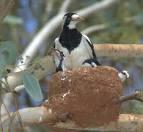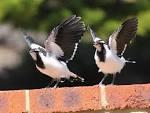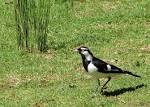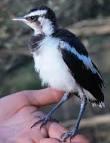Introduction
Climate changes have been attributed to human activities and there are direct impacts evident on the world’s biodiversity. While other threats of climate change may pose greater dangers to humanity, many other species on the Earth may end up distinct or made to shift their ranges in order to survive. Birds are some of the species that are directly being affected by climate change.
Some bird species may benefit from climate changes but a considerable number of them will suffer from this changes. Australia has a wide variety of bird species. This paper will be investigating the effects of climate change on Magpie-lark (Grallina cyanoleuca) birds found in the northern and southern parts of Australia. With climate changes, some of the current ranges where Magpie-lark species are currently occupying may become unsuitable for them, therefore necessitating expansion or moving out (Miller &Vandome, 2010, p142).
Magpie-lark birds are black in color with a white pattern that varies between sexes. The males have eyebrows that are white and have a horizontal black eye strip. The female Magpie-lark bird’s throat and face is white with a vertical stripe that is broad running through the eye with no white eyebrows as the male; magpie-lark birds have black legs and feet with white and thin bills (ClimateWatch YouTube Guides, 2013).
The size of Magpie-lark bird is between 24cm and 30 cm long. Magpie-lark birds’ call is performed mostly by two birds together while lifting their wings. The call rings as “pee-pee’. Although their diet occasionally may include smaller animals, they are well adapted to feeding on insects, spiders, and invertebrates such as snails. They are always seen foraging in pairs. Magpie-lark birds are sedentary types of birds with movement limited to small areas. During off-breeding season, they do form nomadic mobile flocks. Observations in the northern parts of Australia indicate that Magpie-lark birds move to the coast during the dry season and return back during the wet season (Miller & Vandome, 2010, p144).
During the breeding season, both male and female Magpie-lark birds build mud bowl-shaped nests. The nests are lined with grass and feathers. The female lay between 3 and 5 eggs and are incubated by both male and female. The incubation period lasts between 14 and 19 days. While weather conditions may limit rearing of more than one brood in a year, good weather conditions have been observed to allow more than one brood in a year. Both male and female Magpie-lark birds take turns to care for the young ones. The spring season in Australia allows flowers to blossom as the weather is warmer with plenty of rain. This is the period when Magpie-lark birds make their nests and laying of eggs in the southern and northern Australia. With climate changes, the seasons may change and the Magpie-lark birds will have to adapt to drier season as they are more adapted to wet seasons (Olsen, 2001, p114).
Data Collection
Large parts of the Australian continent are desert or semi-arid. The Southern East parts of the continent and the South West are the only parts that have temperate climates. The Northern parts of the continent have tropical climate with some parts being desert. Observation of Magpie-lark birds will be carried out in the Southern East part of the continent.
Sittings Data Observed
From the table above, the number of Magpie larks that were observed courting or mating over the period of observation was 350 as compared to the ones that were feeding the chicks. The number of birds that were observed calling over the same period was 286 compared to the ones that were observed feeding. A very high number of birds at 376 were observed to be on chicks, an indication that the numbers of the bird in this region were going to increase considerably in the coming months. The ones that were on nests and eggs were relatively high during the same period at 156 birds.
Results

The graph shows the number of Magpie-lark birds as observed from the first week of March 2013 to the first week of April 2013. The trend shows the number of birds in the South East of Australia increasing from the beginning of the month and the number keeps on increasing even to the month of April.

Graphical representation of the observations.

Graphical representation of the table above.

The pie chart shows the percentages of birds that were observed feeding young ones between the month of March and April. The percentages from March 6 to April 12, 2013, show an increase in the number of bird-feeding young ones from 2 % to 15% on April 12, 2013. Below are some the areas where the birds were sighted.
- Shepparton.
- Wodonga.
- Benalla.
- Wangaratta.

The pie chat shows the number of Magpie lark birds on nest increasing from the month of March to April. This was attributed to the number of birds that were likely on eggs or laying eggs.


Similarly, the numbers of bird on eggs were observed to increase between the months of March and April. The percentages ranged between 1% and 13% which were similar to the number of birds on nest.


The percentages of bird calling increased considerably between the months of March to April, which were attributed to the increased number of bird in this region. The “pee-o-pee” sound along the road side was distinct as the bird foraged. Most of time the birds foraged in pairs and could be heard calling as way of responding to other pairs calling.


The number of magpie lark bird increased as the numbers of bird feeding were observed along the road sides and on the farmlands. The percentages ranged between 5% on March 6 to 12% on April 5, 2013.


Starting from March 6 to April 12, the percentages of birds on chick increased considerably. The percentages ranged from 2% as observed to 11% on April 12, 2013. With the month of May, which is expected to have increased rainfall approaching, this numbers were expected to increase.

Discussion
The breeding pattern of Magpie lark birds as indicated from climate watch (2013) website is not definite as they are known to be opportunistic in breeding patterns depending on climate conditions. The northern side of the Australian continent, the Magpie lark birds are known to breed at any time, but in the southern parts of the continent, the Magpie bird has been observed to breed during the months of August to February. The observation of the bird breeding in the months of March on ward shows a changed pattern in their breeding trends. Magpie lark birds are known to inhabit open or lightly timbered habitats. In these observations, the birds could be seen in more open spaces along the road sides and open spaces on the farmlands. Observations in Shepparton, Wodonga, Benalla and Wangaratta farmlands indicated the birds were adapting to open farm fields and urban settings.
The weather around Melbourne and to the North East of Victoria state in the month of March averaged between 24°C and 14°C. Magpie lark birds were observed in the whole Victoria State but with varying numbers. The birds are more adapted to those areas that are wet due to their need for mud to build their nest.
The tropical regions of the continent are in the northern sides including Queensland, the northern and central territories. A period from December to March is when the Magpie lark birds have an opportunity of breeding in these regions. The temperature in the wet season from December to March averages between 30°C and 50°C due to the levels of humidity. This is the most appropriate time for the Magpie lark bird to breed. With approach of the dry season, the bird’s starts to migrate to the southern parts of the country.
The observations of gradual increase in the number of birds in the southern parts of the continent from the month of March towards April are a clear indication of this phenomenon. The dry season equally lasts for six months starting from the months of May to October (USA National Phenology Network resources, 2013). The birds as observed have started migrating from these regions earlier than expected. The weather in the regions of southern Australia is quite changeable thought the year with temperatures averaging 30°C.
The birds that were seen breeding were observed to be in pairs. The birds were more aggressive towards the researcher as way of protecting their nests. The nests were mostly observed to be placed on branches near water in the farmlands, while Magpie lark that were foraging and breeding along the roadside had their nest on horizontal beams of telephone poles. Literature from climate watch indicates that the birds usually breed between the months of August and February in the southern parts of the continent, but from the observations, this trend is changing with more bird breeding during the months of March and April as observed. While Magpie lark lays between three and five eggs, some of the nests observed could not accommodate more than three chicks.
The birds that were observed calling were in most cases paired and could be seen responding to calls from other pairs. Rarely did the observation sight a single bird calling. The flipping of wings while calling was attributed to defending of territory. When approached by human beings, other pair of Magpie lark birds or any other specie of birds they increased calling while flipping the wings. Research indicates that the calling increases with new birds approaching a pair’s territory. The high numbers of birds calling indicated a higher number of new birds in the territory. This is an indication that more bird were migrating in this regions during that period of the year. Migrations of Magpie larks to the south are generally known to come from the northern parts of the continent due to dry season in those regions.
The birds were observed foraging on enormous range of habitats’. Most of the areas they were observed were open areas on agricultural farmlands and open spaces in the urban areas. The ranges where they observed to forage at most were in areas close to the waters and on soft open grasslands. The birds were observed to feed on insects and other small creatures. Although human activities of clearing farmlands may have affected other species of birds, Magpie larks benefits from this cleared spaces as they like foraging in open spaces. There were no groups of Magpie larks or flocks observed although literature indicates that they do make loose groups in areas with bountiful feed.
Conclusions
The research was carried out to determine the effects of climatic changes in Australia and their impacts on the magpie lark birds. The research established that there are no distinctive changes in the ranges where Magpie Lark occupies in the southern parts of Australia. The only marked observation of the research was the change in Magpie Lark Bird’s migration pattern from the northern regions to the southern regions. This was arrived at due to the increasing numbers of Magpie lark birds in southern regions during the months of March. Increased number of birds breeding at this time of the year indicates that, the northern region was experiencing climatic changes that were not favorable for Magpie lark birds. At the same time, the southern parts were increasingly becoming wet: conditions that are favorable for Magpie lark breeding.
According to research phonological changes on migratory, birds are expected to be observed when they reach their destinations due to climate changes. When arriving from migrations, Magpie lark birds tend to live in densely populated areas, hence the high levels pitch calling of the birds (Miller & Vandome, 2010, p146). From the research, Magpie lark distribution range in the southern parts of the continent has not changed. While climate changes in the northern territories do affect the number of broods the Magpie lark produce in a year, the favorable climates in the southern part of the continent allows Magpies lark to produce more broods throughout the year. As the southern parts of the continent approaches the heavy rainfall season of May to October, Magpie lark breeding will be affected by the rains as they make their nests using mud.
According to literature, rain is the only external factors of climate change that affects Magpie lark breeding. Magpie lark birds indicate that it is more suited to clear, open grassland rather than in those areas with bushes. The heavy clearing of the farmland in the areas observed, and introduction of water troughs for farm animals by human beings creates ideal conditions for the Magpie lark to make these regions some of their favorable habitats’. This is reflected in the number of birds recorded during the observations. The presence of the Magpie lark in suburban areas that were observed is in line with behavior of this species’ of birds. Magpie lark in the observed regions did not indicate any discrimination between the urban and rural areas as well. Foraging in the urban areas allows the bird to take advantage of the open spaces. The new urban open spaces have bountiful of food supply for the birds.
The research hypothesis was intended to unveil the phenological impacts and adjustments of Magpie Lark to climate changes. The analysis from the results and the data collected indicates that the Magpie lark ranges of foraging has no marked changes with climatic changes. The bird with its adaptability to changing environments is not likely to be affected by climate changes in the future.
References
ClimateWatch YouTube Guides 2013. Web.
ClimateWatch 2013, (birds). Web.
Leach, JA 2005, p35, An Australian Bird Book: A Complete Guide to the Identification of Australian Birds, Kessinger Publishing, Edition Reprint.
Miller, FP & Vandome, AF 2010, p146, Magpie-Lark, VDM Publishing, Saarbrücken, Germany.
Olsen, P 2001, p114, Australian Birds, Edition reprint, Kessinger Publishing.
USA National Phenology Network resources 2013. Web.